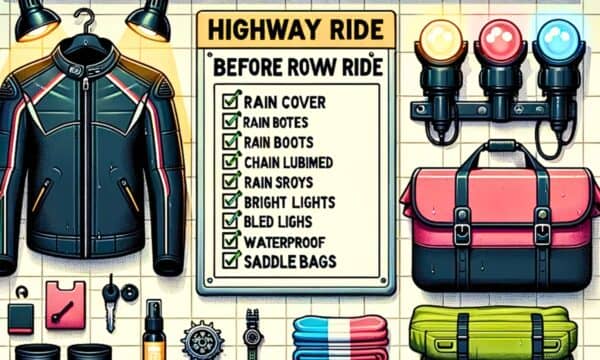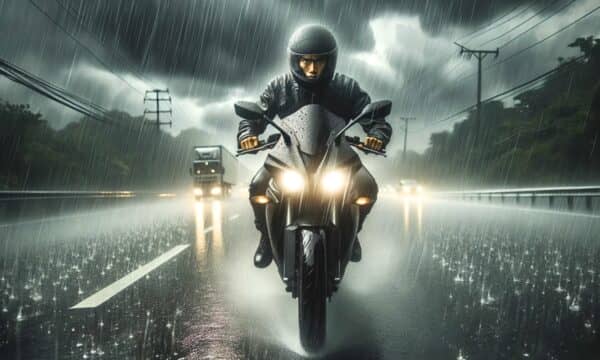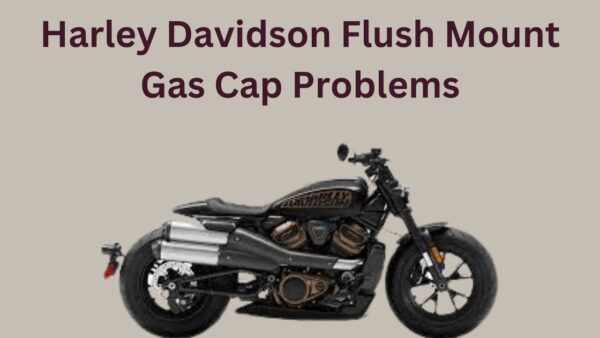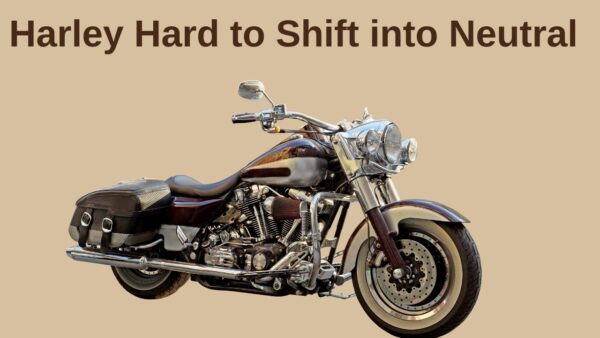Riding a motorcycle on a Highway in the rain is a level exciting moment for everyone. But did you ever think about the problems you could face while riding in the rain on the Highway?

If you did not know about the precautionary measures on How to ride a motorcycle on a Highway in the rain then don’t worry.
Here we will discuss everything you should know before riding in the rain.
Let’s dive into:
How to Ride a Motorcycle on a Highway in Rain?
Riding a motorcycle in the rain on the highway requires additional precautions and skills to navigate safely through challenging conditions.
Here are some tips and considerations for those who might find themselves riding under such circumstances:
1. Check Everything Before Riding
Before setting out on a motorcycle ride in the rain, it is essential to perform a pre-ride checklist.
It includes checking your gear, inspecting your motorcycle, and considering the weather and travel conditions.

Here is a comprehensive pre-ride checklist:
- Make sure that you have rainproof gear, including a waterproof jacket and pants, gloves, and boots. They will keep you dry and prevent you from getting cold, which can lead to hypothermia if you’re not careful.
- Ensure that your motorcycle is in good working order. Pay close attention to the tires and make sure they are properly inflated and have sufficient tread. The brakes should be responsive and the lights should be functioning properly.
- Check the weather forecast before you leave. If heavy rain is predicted, consider postponing your ride. It’s crucial not to underestimate the dangers of riding in heavy rain.
- Try to stick to main roads and highways where possible. These roads tend to be better maintained and drained than smaller roads.
2. Reduced Speed
When navigating through highway conditions in the rain on a motorcycle, it’s crucial to modulate your speed appropriately.
High speeds can be particularly dangerous as they reduce the motorcycle’s grip on the road and increase the stopping distance.
Related: Top 5 Winter Riding Gears You Must Have
Rain can make the tarmac slippery, leading to a higher likelihood of skids, so it’s better to slow down and ensure you have ample time to react to any potential hazards.
3. Increased Following Distance
It is important to avoid any accident that you should maintain the space between your bike and the vehicle in front of you.
Because motorcycles take double or even triple the amount of time to stop on a wet road.
With increased following distance you will have an adequate time to react to any sudden changes and obstacles in your path.
4. Smooth Control
Maintaining smooth control of your motorcycle is important when riding in the rain on a highway. To achieve this, gentle movements are key; avoid sudden braking, acceleration, or sharp turns.

Begin by gradually applying the front and rear brakes to prevent skidding. Moreover, use the throttle sparingly and smoothly to avoid losing rear wheel traction.
When it comes to navigation, instead of abrupt turns, opt for slow, steady cornering.
5. Avoid Road Paint and Metal Surfaces
It’s crucial to steer clear of road paint and metal surfaces. These materials become particularly slippery when wet, increasing the risk of skidding you may lose control of your bike.
Road markings and metal manhole covers are prime examples of areas to avoid. Instead, aim to ride on the gritty part of the lane where you’ll have more traction.
6. Mental State
Maintain a calm and focused mental state when riding a motorcycle on the highway in the rain. The unexpected change of weather can be daunting, but it’s essential to avoid panic in such situations.
Anxiety can lead to hasty decisions, which may not be the safest choice when the road is wet and slippery.
Remember to breathe regularly, remain relaxed, and maintain your focus on the road. Also, continually assess road conditions and traffic around you to make the best possible decisions on the go.
Confidence in your riding skills plays a pivotal role here, but remember that overconfidence can lead to risky behaviour.
7. Avoid Puddles and Standing Water
When riding a motorcycle in the rain, it’s important to meticulously avoid puddles and areas of standing water.
These seemingly harmless water patches can hide dangerous hazards such as potholes, debris, or oil slicks that could potentially lead to loss of control.

Furthermore, riding through standing water increases the risk of hydroplaning, where your motorcycle’s tires lose contact with the road surface, making steering and braking much harder.
To mitigate these risks, always scan the road ahead for puddles and standing water, and safely maneuver around them whenever possible.
8. Turn on Your Lights
Turning on your motorcycle’s lights is an essential safety measure that will enhance your visibility to other road users, ensuring that you can be seen even through the downpour. Utilize both your headlight and tail light for optimal visibility.
It’s also best to invest in high-quality lights with a strong beam of light that can penetrate the rain, ensuring you’re noticed by other drivers.
Always remember, that visibility is key when navigating highways during inclement weather conditions.
9. Ride in the Tracks of Vehicles Ahead
When riding a motorcycle on a rain-lashed highway, it’s better to follow the paths used by the vehicles ahead.
In rainy conditions, the centre of the lane can get greasy and slippery due to oil and dirt accumulation.
However, the tire tracks of preceding vehicles offer a relatively cleaner and drier path. These tracks are generally less slippery, providing better traction for your motorcycle.
Is it OK to ride a motorcycle in the rain?
Riding a motorcycle in the rain is not necessarily prohibited, but it does come with increased risk and demands additional precautions.
Wet conditions can significantly reduce visibility and traction, increasing the likelihood of accidents.
If you need to ride in the rain, ensure you’re equipped with proper rain gear, a helmet with a clear visor, and a motorcycle with good-quality tires specifically designed for wet surfaces.
Furthermore, remember to maintain lower speeds, avoid sudden braking, and keep a safe distance from other vehicles on the road.
Thus, while it’s OK to ride a motorcycle in the rain, it’s essential to take these additional measures to ensure safety.
What to do when riding a motorcycle in the rain?
When riding a motorcycle in the rain, safety should be your primary concern. Always ensure you’re wearing waterproof gear, including gloves and a jacket, to keep you dry and warm.
Visibility can be reduced in wet conditions, so opt for a helmet with a fog-free visor. Maintain a safe distance from other vehicles as stopping distances can increase when it’s raining.
Be extra cautious on bends and turns, as the road can be slippery. Try to stay in the tire tracks of the vehicle in front of you as these areas tend to have better traction.
Lastly, ensure your motorcycle’s lights are working properly for better visibility. Remember, the key is to ride smoothly without any sudden acceleration or braking.
What is the safest way to ride a motorcycle in the rain?
Riding a motorcycle in the rain safely demands a combination of adequate preparation, attentiveness, and adjustments in riding techniques.
Before you set off, ensure your motorcycle is in good working condition, with proper tire tread depth and inflation, and functional brakes and lights.
Wear suitable rain gear for visibility and protection, including a helmet with a clear, anti-fog shield. Once on the road, increase your following distance to allow for increased braking time.
Avoid sudden braking or sharp turns, as these can lead to skidding. It’s also crucial to stay vigilant for road hazards like puddles or slippery surfaces and to use your body to signal your intentions to other drivers.
Lastly, consider reducing your speed to maintain control of your motorcycle in wet conditions.
You may also like to read!
What Happens if you ride Honda Grom on Highway

Ahtsham Younas is a passionate blogger and content writer. He loves to ride motorcycles and learn the mechanical process behind the motorcycles.
He has been writing articles in the motorcycle industry since 2019 and has learned many things about motorbike niches.


